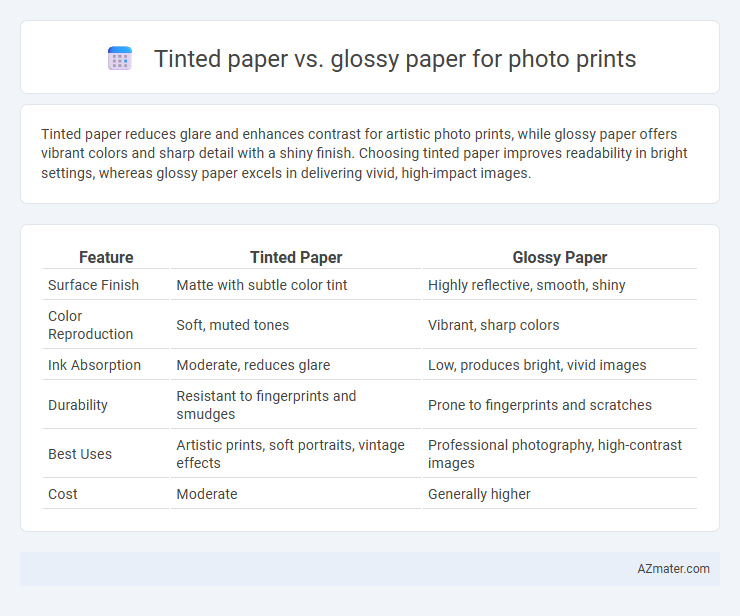Tinted paper reduces glare and enhances contrast for artistic photo prints, while glossy paper offers vibrant colors and sharp detail with a shiny finish. Choosing tinted paper improves readability in bright settings, whereas glossy paper excels in delivering vivid, high-impact images.
Table of Comparison
| Feature | Tinted Paper | Glossy Paper |
|---|---|---|
| Surface Finish | Matte with subtle color tint | Highly reflective, smooth, shiny |
| Color Reproduction | Soft, muted tones | Vibrant, sharp colors |
| Ink Absorption | Moderate, reduces glare | Low, produces bright, vivid images |
| Durability | Resistant to fingerprints and smudges | Prone to fingerprints and scratches |
| Best Uses | Artistic prints, soft portraits, vintage effects | Professional photography, high-contrast images |
| Cost | Moderate | Generally higher |
Introduction to Photo Paper Types
Tinted paper and glossy paper offer distinct finishes for photo prints, influencing the overall image appearance and durability. Tinted paper provides a subtle color tone that enhances mood and depth, making it ideal for artistic or vintage-style photos. Glossy paper features a shiny, reflective surface that delivers vibrant colors and sharp details, commonly preferred for high-definition photographs and professional presentations.
What is Tinted Paper?
Tinted paper is photo paper infused with subtle color shades such as warm beige, soft pink, or cool gray, enhancing the mood and depth of printed images. It reduces glare and reflections compared to glossy paper, providing a unique matte finish that accentuates tonal variations and fine details. Photographers often choose tinted paper to achieve artistic effects and a more textured, tactile quality in photo prints.
What is Glossy Paper?
Glossy paper features a shiny, reflective coating that enhances color vibrancy and sharpness in photo prints, making images appear more vivid and detailed. This type of paper is ideal for high-contrast photos and prints that require a polished, professional finish. While glossy paper can show fingerprints and glare under bright light, its smooth surface is favored for producing striking visual impact in photo printing.
Image Quality: Tinted vs. Glossy
Tinted paper offers a unique matte finish that reduces glare and enhances subtle color tones, providing softer image quality ideal for vintage or artistic photos. Glossy paper delivers vibrant colors with higher contrast and sharpness, making images appear more vivid and detailed, perfect for high-resolution photo prints. Choosing between tinted and glossy paper depends on the desired visual effect and lighting conditions for display.
Color Reproduction and Vibrancy
Tinted paper for photo prints offers a unique color cast that can subtly alter hue perception, often softening vibrant tones and reducing overall color accuracy compared to glossy paper. Glossy paper excels in color reproduction and vibrancy due to its reflective surface, enhancing contrast and saturation for vivid, true-to-life images. Photographers seeking sharp, bright prints with maximum color impact typically prefer glossy paper over tinted options.
Durability and Longevity
Tinted paper offers moderate durability with a matte finish that resists fingerprints and glare, making it less prone to visible wear over time compared to glossy paper. Glossy paper provides vibrant color reproduction but is more susceptible to scratches, fingerprints, and fading when exposed to UV light or moisture. For photo prints requiring long-term preservation, acid-free tinted paper with archival-quality coatings generally ensures better longevity and resistance to environmental damage.
Fingerprint and Smudge Resistance
Tinted paper offers a matte finish that significantly reduces fingerprint visibility and smudging compared to glossy paper, making it ideal for handling and display. Glossy paper, with its smooth and reflective surface, tends to attract fingerprints and smudges more easily, which can degrade photo clarity and require frequent cleaning. Choosing tinted paper enhances print durability and maintains image quality by minimizing the impact of oils and residues from fingers.
Reflection and Viewing Angles
Tinted paper reduces glare by absorbing ambient light, resulting in softer reflections and better visibility from various viewing angles, making it ideal for prints displayed under bright lighting. Glossy paper produces sharp, mirror-like reflections that enhance color vibrancy but can cause distracting glare and limited viewing angles due to surface shine. Selecting between tinted and glossy paper depends on the display environment and the importance of minimizing reflection versus maximizing color intensity in photo prints.
Best Use Cases for Each Type
Tinted paper excels in producing vintage or artistic photo prints where muted tones and subtle color shifts enhance the aesthetic, making it ideal for portraits, sepia-themed images, and creative projects. Glossy paper provides vibrant color reproduction and sharp detail, perfect for high-resolution images, commercial photo prints, and professional portfolios that demand bright, glossy finishes. Choosing tinted paper suits artistic expression and mood, while glossy paper is best for showcasing vivid colors and intricate details in photography.
Conclusion: Choosing the Right Photo Paper
Choosing the right photo paper depends on the desired aesthetic and durability; tinted paper offers a matte finish that reduces glare and enhances subtle color tones, making it ideal for artistic and vintage-style prints. Glossy paper provides vibrant colors and sharp detail with a shiny surface, perfect for high-impact images and photos requiring a polished look. Assessing the intended use and display environment will guide the best choice between tinted and glossy photo papers to achieve optimal print quality.

Infographic: Tinted paper vs Glossy paper for Photo print
 azmater.com
azmater.com